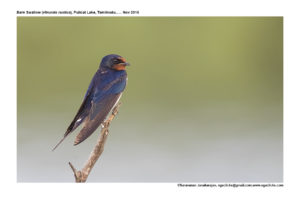Barn Swallow

Barn Swallow Hirundo rustica
Etymology:
- Hirundo : Latin word for Swallow
- Rustica : Latin word for rural, rustic, plain derived from rus – country
Vernacular Names :Baluchistan: Kirkishi, Totaki, Hindi: SamanyaAbabil, Kash: Katij, Pun: Ababil, Naire, Gond: Paras pitta, Ben: Ababil, Lalababil, Guj: Derasariababil, Shiyalutharodiyu, Mar: Bhandik, Mal Bhingari, Ta: Talaiillathakuruvi, Adaikallankuruvi, Tampadi, Te: Wanakoyela, Mal: Vayalkoti, Kan: Banakki, Kavalutokae, Sinh: Wehilihiniya
Distribution in India: Widespread winter visitor and breeds in Himalayas and North EastIndia.
Description: Size of 17–19 cm; wt. of 16–24 g. It has a distinctive plumage pattern and long tail-streamers. The male of the nominate race has rufous-chestnut forehead, crown and upperparts are glossy steel-blue; wings and tail are black, white patches on inner webs of rectrices, outer tail feathers are greatly elongated; throatis rufous-chestnut, broad steel-blue onbreastband; rest of underparts, including undertail-coverts and underwing-coverts are creamy or buffy white. The female is less glossy, with shorter tail-streamers. The juvenile is duller;forehead and throat are paler and has a short tail.
Habitat:It is found in open country, cultivation, human habitations, often near water. From sea-level to 3000 m. Roosts mainly in reedbeds or other dense vegetation in or near water, tall grasses, crops, bushes or tree canopy; also on overhead wires in towns, and on or in buildings, especially in cold weather.
Food habits: It eats insects, hoverflies, horseflies and blowflies, aphids, flying ants and termites. It feeds alone or in pairs in breeding season, mostly low down, above ground or water. It forages over variety of open habitats, in adverse weather also often over waterbodies. Its flight is straight and rapid, with frequent sharp turns to catch prey; infrequent, short glides. It takes prey from ground, vegetation, water or other surfaces, while either perching or hovering, especially in adverse weather. Follows other animals and tractors to take insects flushed by them..
Breeding habits: They breed in Jun in Finland, Feb–Mar in N Africa; Nov–Mar in Argentina. It is socially monogamous, occasionally polygynous; extra-pair paternity is common. The male attracts females to nest or site by displaying tail and singing, also communal singing displays while circling above breeding site.The male sings to solicit copulation, which occurs on perches outside as well as near or in nest, also guards mate during nest-building and egg-laying. Both the sexes buildthe nest. The nest is a cup or half-cup, made from mud pellets mixed with fibres such as dry grass, straw and horsehair, lined with dry grass, then white feathers. The nest construction takes 7–10 days, with additional few days for lining. The female adds feathers during incubation and removes them as nestlings grow. The nests are often repaired and reused, with mud added to rim, can last for 12–15 years. The nest site is originally in cave or cliff, sometimes in hollow tree,building, barn, bridge, culvert, well or mine shaft, and placed usually above ground or water on ledge or vertical wall close to an overhang. They lay a clutch of 2–7 eggs. The incubation is done by female alone in and the male does small and variable amounts of incubation.The incubation period is 13–16 days. The eggs hatch mostly over 1 day. Thechicks arebrooded at decreasing rate for 6–9 days; older chicks still brooded in bad weather and at night and fed by both sexes. The young leave nest between 18–27 days and stay near site and away from other families, roost in nest, and fed by parents for 1 week. They become independent after 1–2 weeks.